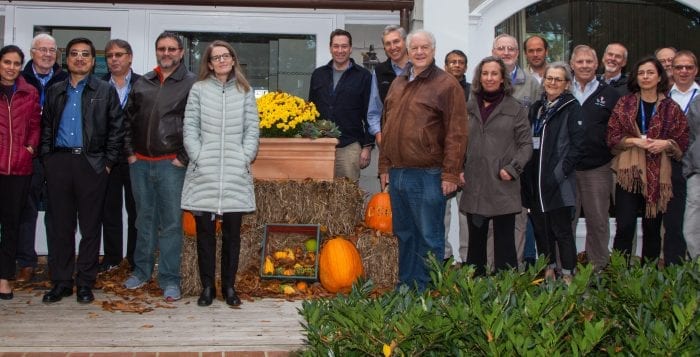Lyme disease, the increasingly common tick-borne disease, may soon be preventable.
Experts from academia, government and industry have been discussing at Cold Spring Harbor Laboratory’s Banbury Center the benefits and scientific feasibility of developing a vaccine that would essentially stop the infection in humans.
The highlights of those discussions are summarized in a new study published Oct. 17 in Clinical Infectious Disease. Its conclusion:
“We are now positioned at a crossroad where advanced technologies allow for application of new genetic strategies for immunizations, possible identification of new immunogens, and repurpose of proven vaccine candidates not only for humans but also for domestic animals and environmental reservoirs.”
In laymen’s terms: New techniques are there, it’s creating a lot of excitement and there’s hope.
The study is the culmination of more than 3 years of meetings held at the lab, where the most promising strategies for counteracting the infection were discussed.
Lyme disease is caused by a bacterium transmitted through the bite of an infected tick. Traditionally, vaccines have been used to treat infectious diseases and rely on human antibodies to attack the germ. One of the new vaccines, which might be used in combination with traditional techniques, actually impacts the tick.
“What was discovered several years ago, to everyone’s surprise, a Lyme vaccine worked inside the tick itself and inactivated the Lyme bacteria. Newer vaccines are being designed to disrupt the mechanism for transmission of the Lyme bacteria from tick to human,” said Dr. Steven Schutzer, one of the study’s lead authors.
Researchers cannot speculate when the vaccines will become publicly available, but they said they feel encouraged that they are in the pipeline with some trials underway.
Lyme disease can be treated with antibiotics, such as doxycycline, and is most successfully eradicated with early diagnosis. The only preventative measure to date, the researchers note, is to simply avoid tick bites. That strategy, though, has been ineffective at stopping the disease’s prevalence. Each year, more than 300,000 people are diagnosed with the disease. In Suffolk County, 600 people are diagnosed with Lyme disease, the highest rate in New York State.
Lyme disease symptoms include fever, fatigue and headache, symptoms that often mimic other illnesses. It is often diagnosed by its characteristic bullseye skin rash, but not all cases present with a rash. Left untreated, the disease can infect the joints, heart and nervous system. Some people suffer from a post-treatment Lyme disease syndrome and have trouble thinking six months after they finish treatment, according to the Centers for Disease Control and Prevention.
Former Suffolk County Legislator Vivian Viloria-Fisher was recently diagnosed with meningitis, induced she said, by a severe case of Lyme disease. After hearing other people’s stories about how Lyme disease can cause major illnesses, even a heart attack, she said a vaccine would be welcomed.
During the Cold Spring Harbor meetings, a recognition emerged among participants that an effective vaccine was an important public health tool and the best path to follow to counteract the disease.
Schutzer emphasized, though, that getting vaccinated for Lyme disease, a noncontagious disease, would be a personal choice, rather than a public health mandate.
“When the pathogen is highly contagious, vaccines are most effective when a large population is vaccinated, creating herd immunity, and leading to the protection of the individual and of the community,” the researchers state in the study. “A vaccine directed against the causative agent B. burgdorferi, or against the tick vector that transmits this bacterium, will only protect the vaccinated person; thus, in this case, herd immunity does not apply toward protection of the community.”
Stony Brook University researcher Jorge Benach participated in the meetings and noted Lyme vaccines are currently available for dogs but not appropriate for humans.
“There’s clearly a need,” he said. “A lot of things need to be considered before an approval of a vaccine.”
One of those factors: 25 percent of ticks carrying the Lyme bacterium also carry other infectious organisms.
Both researchers said they valued the rare opportunity to commingle, discuss and share expertise about a certain aspect of science under one roof during the Banbury Center’s meetings on Lyme disease.
Dr. Rebecca Leshan, executive director of the Banbury Center at Cold Spring Harbor Lab, is proud that the meetings can impact the wider community.
“I can’t overemphasize the importance of the small meetings convened at the Banbury Center of Cold Spring Harbor Laboratory,” she said. “They provide a truly unique opportunity for experts to engage with counterparts they may never otherwise meet and stimulate new ideas and strategies. And the beautiful Lloyd Harbor setting may provide a bit of extra inspiration for all those who participate.”
The first meetings of the group resulted in improved diagnostics that has already had major effects, with FDA approval of a number of tests. Outcomes from the most recent meetings, she said, continue to set the right course of action.





